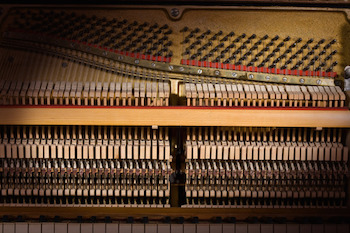What’s one of the most important parts to any piano? Arguably, many people would point towards the pinblock.
The pinblock is designed to hold the tuning pins tightly in place so the piano does not go out of tune. Pinblocks are usually made of hard maple or beech wood, and are usually laminated so that the end grain of the wood presses up against the tuning pin from multiple directions.
Tuning pins are about 2 ½ inches long and are made of steel. They are embedded into the pinblock about an inch in depth, with the remaining inch being visible above the wood.
In most cases, tuning pins become loose for one of two reasons.
First, the pinblock may simply be worn out. After years of tuning the pins and moving them back and forth, they simply cause the hole in the wood to be larger than the pin itself. Its similar to a wood screw that has been stripped.
Second, the more serious of the two problems can be a cracked pinblock. Cracks can form in the pinblock between two or more of the tuning pins. The crack causes the holes to open up and the pins become so loose they will not stay in place. Cracks can be caused by a number of things, including an excessively dry environment, or by an inexperienced technician who pounds the pins in without the proper support from behind.
Is the pinblock worth replacing? That all depends on the piano and the pinblock. If a pinblock is cracked in an inexpensive upright, its often not worth the cost of fixing it. If a name brand grand piano is suffering from a worn out pinblock, a trained technician may be able to restring the piano using oversized tuning pins, and give your piano several more decades of life.
The only way to know for sure is to have a trained technician inspect your piano. Give us a call today.

